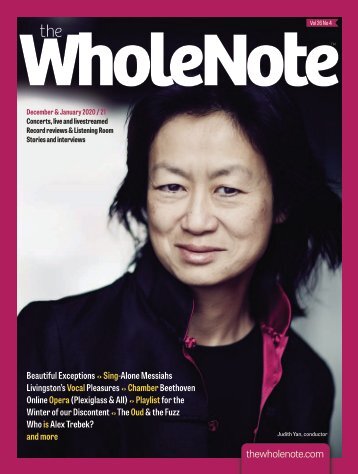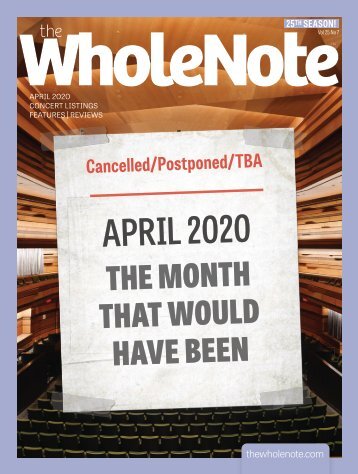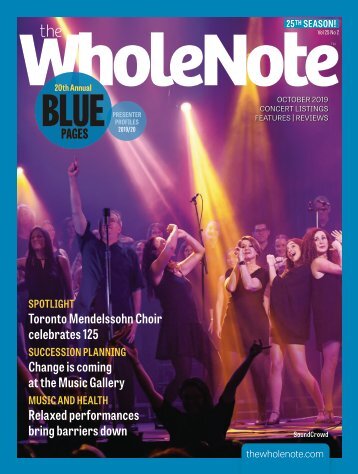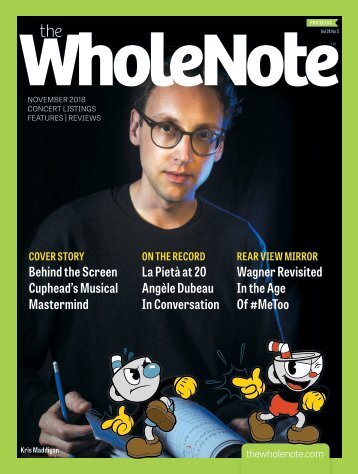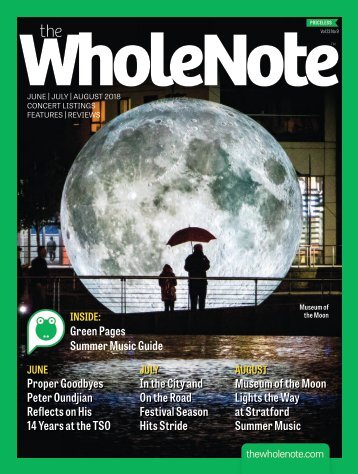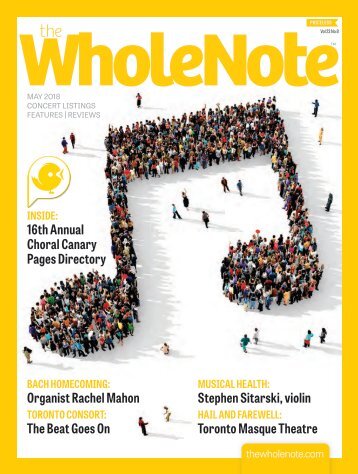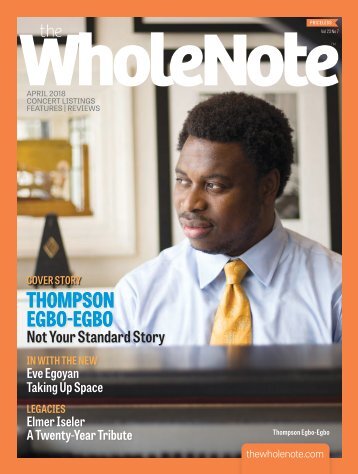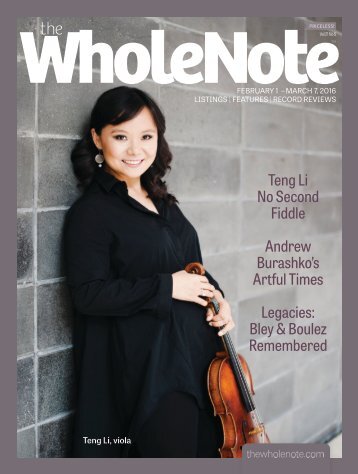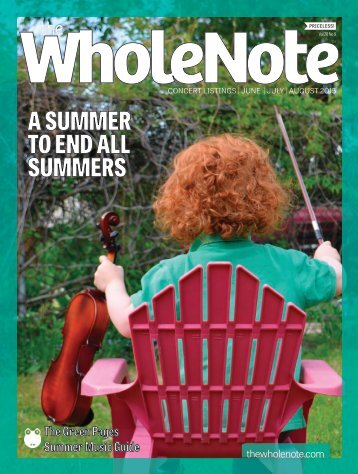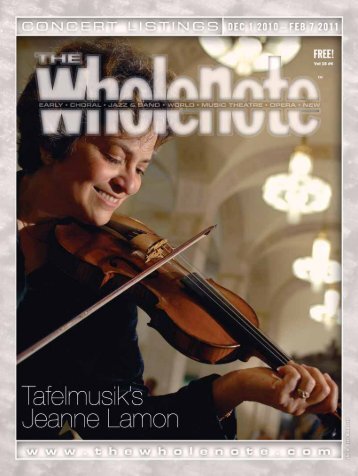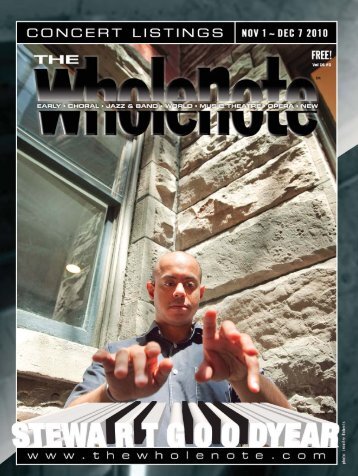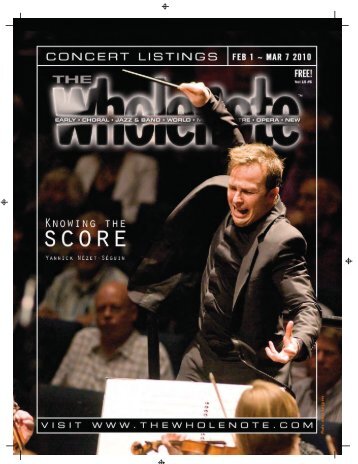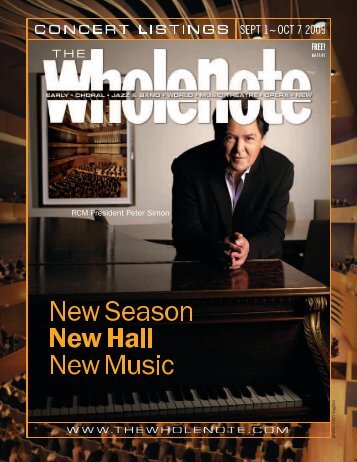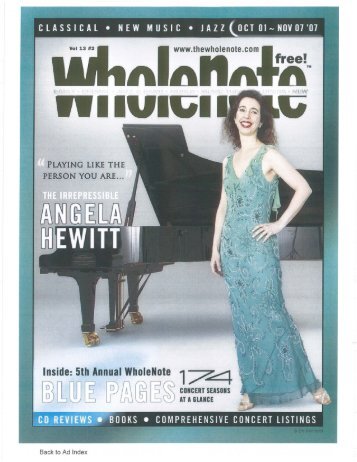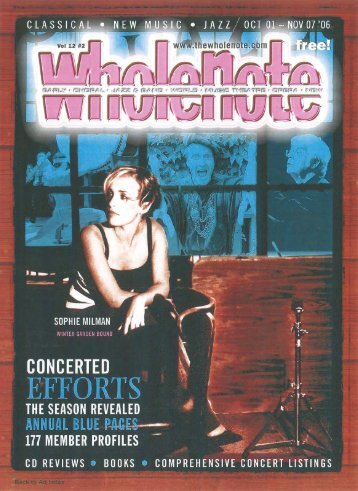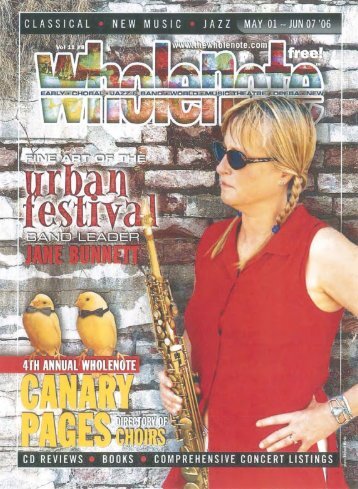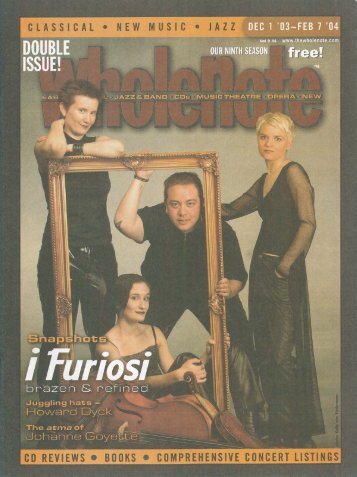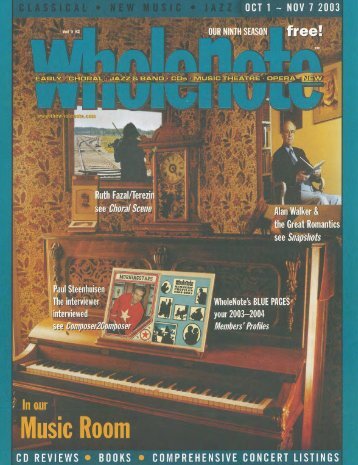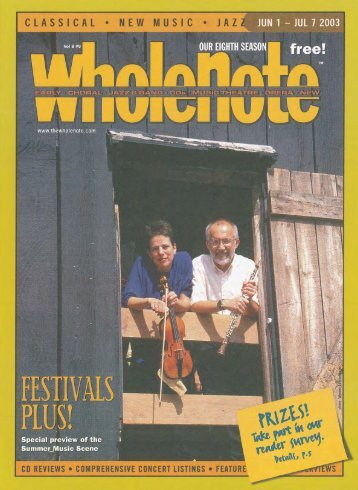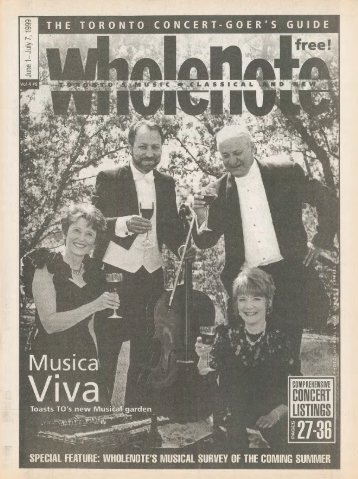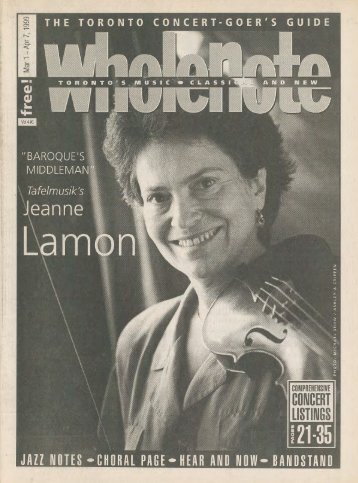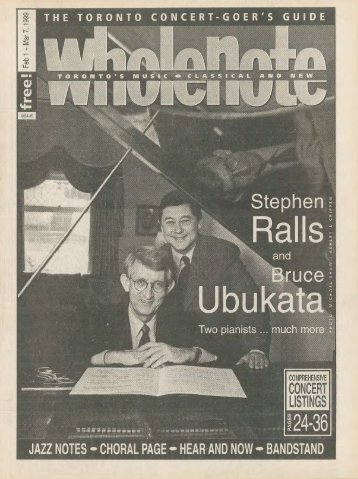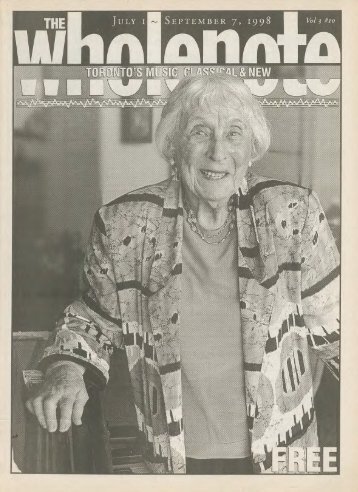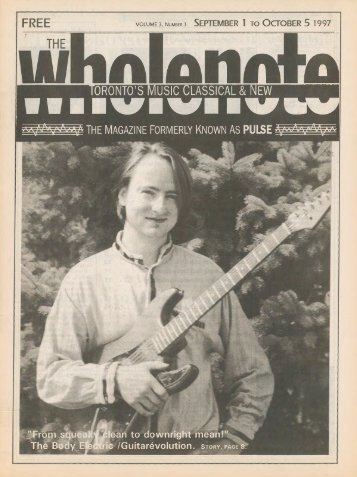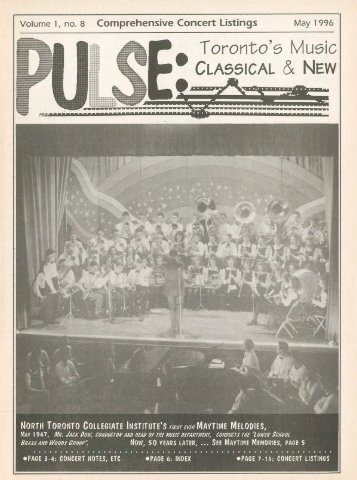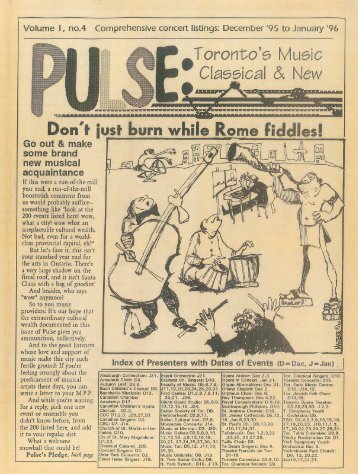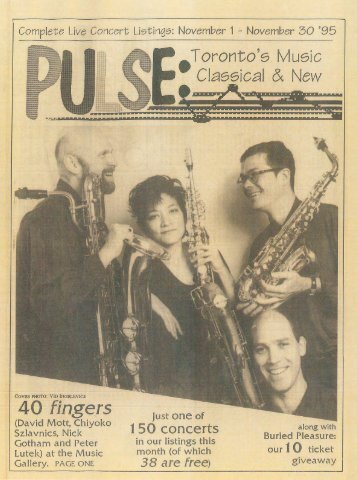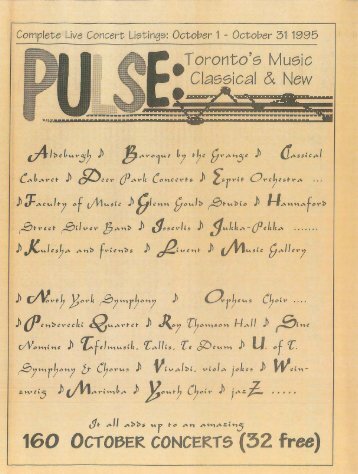Volume 25 Issue 9 - July / August 2020
- Text
- Composer
- Orchestra
- Concerts
- Symphony
- Musicians
- Artists
- Musical
- Toronto
- August
- Jazz
July/August issue is now available in flipthrough HERE, bringing to a close 25 seasons of doing what we do (and plan to continue doing), and on stands early in the week of July 5. Not the usual bucolic parade of music in the summer sun, but lots, we hope, to pass the time: links to online and virtual music; a full slate of record reviews; plenty new in the Listening Room; and a full slate of stories – the future of opera, the plight of small venues, the challenge facing orchestras, the barriers to resumption of choral life, the challenges of isolation for real-time music; the steps some festivals are taking to keep the spirit and substance of what they do alive. And intersecting with all of it, responses to the urgent call for anti-racist action and systemic change.
Kylie Jefferson CHORAL
Kylie Jefferson CHORAL SCENE IN THE ABSENCE OF SINGING, UNCERTAINTY BRIAN CHANG to choreographing much of what we will see in the class and rehearsal studios, to consulting on the choice of guest choreographers for each episode, to being part of the team in the edit suite in post production. She was also part of the team determining the music that would be used for the dance sequences. Taking their cues from each episode’s script, the show’s two music supervisors, Scott Belluz and Natasha Duprey, would present a list of possible choices (from pop songs to hip-hop to classical music of different eras), to the team who would then choose what would work best, both dance-wise and narrativewise in each scene. This was particularly important as “tucked into the excerpts of the dances the students are learning and performing are reflections of what they are going through in their lives, their sexuality, their frustrations, their struggle to find a place in the world.” It’s is similar to the way original songs written for the TV series Smash echoed the characters’ lives but, as Jennifer emphasizes, “this is unique in a TV show about dance,” and she hopes it will help to draw viewers to the program. Part of what will make this so powerful, she believes, is how the complex musical tapestry weaves together contemporary and classical music, even counterposing the two, as when the choreographer of the school’s year-end showcase decides to re-envision his ballet and the music gets changed from a classical string variation by British composer Benjamin Britten to a wildly modern work by Canadian composer Nicole Lizée. Weaving the whole together is the underscoring by show composer James Jandrisch. One of the central storylines — which seems prescient now in the wake of the first wave of protests, although the show finished filming in December — focuses on Neveah (Kylie Jefferson), a young Black girl from L.A. who, right from the beginning, has to fight the stereotypes typical of the ballet world, fiercely determined to prove her ability and her right to a place in the school. It’s a through-line, Nichols says, that has the potential both to draw viewers to the show and new audiences and potential dancers to the art form. If the show is picked up for future seasons, she says, both she and her colleagues hope to continue exploring such current issues After all, “If we want to affect change in the ballet world as well as the world at large, this is a great platform. Through TV pop culture we can hope to really reach a lot of people.” Tiny Pretty Things will debut in the fall of 2020 on Netflix. Jennifer Parr is a Toronto-based director, dramaturge, fight director, and acting coach, brought up from a young age on a rich mix of musicals, Shakespeare and new Canadian plays. Anyone who sings in a choir has likely seen the tragic story of the Amsterdam Mixed Choir where after a performance of the Bach St John Passion, 102 of the 130 choristers were sickened by COVID-19. One of those members would pass away from the virus in the following weeks, just as news also broke of the Skagit Valley Chorale in Washington State where 52 members would ultimately be infected, with two deaths. Smaller group outbreaks were noted in other choirs around the world such as the Berlin Cathedral Choir and in many faith-based settings. The headlines are enough to make any person take pause. The choral community has been shaken particularly hard by these stories as, for many, choir is their escape from the pain and stress of the world, not the cause of it. In the absence of clear scientific evidence, the precautionary principle has provided the only guidance available to choirs throughout much of the pandemic so far. Organizations have not waited to take strict action, instead choosing to comply with blanket safety, quarantine and shutdown measures. For every choir in Ontario, it is now over three months since any rehearsals. Seasons were ended early, summer festivals are cancelled, tours are out of the question, and uncertainty reigns, with planning for next season made difficult by differing assumptions of what may be. The choral world is not a small industry and leaders have convened to provide coherence amidst the confusion. On June 23, an open letter was released by heavy hitters of the Canadian choral world including Lydia Adams of the Elmer Iseler Singers, Ivars Taurins of Tafelmusik, Kari Turunen of the Vancouver Chamber Choir and Mark Vuorinen of the Grand Philharmonic Choir, amongst many others. “With new studies being published from various worldwide sources re-evaluating earlier claims on the risk of singing and the 18 | July and August 2020 thewholenote.com
Dr. Joan Robinson (left) with Kellie Walsh, President, Choral Canada, in their May 2020 webinar transmission of COVID-19, we feel that a new dialogue must ensue to ensure a safe, prudent return to choral singing in our communities on an equal footing with the reopening of other sectors,” states the letter. “We ask for a more collaborative dialogue in establishing guidelines on reopening this important sector of society, as has occurred in industries with similar health concerns. To segregate one important activity that impacts so much of Canada’s culture, history, economy, tourism, education and mental health, is troublesome for all of us and has not provided a balanced, positive and safe way to move forward into the future.” This followed a day after a letter written by Vuorinen in his capacity as president of Choirs Ontario, stating “we are asking for public health departments to help the tens of thousands of Mark Vuorinen choristers in this province by providing clear and actionable guidelines for choral singing that are guided by science.” The letters argue that with the exception of the high-profile superspreader events in Skagit Valley and Amsterdam, there is little other evidence connecting choral singing to high-risk spread of COVID- 19. Both letters reference a variety of sources that are starting to build scientific evidence of transmission risks, but haven’t indicated any compelling evidence of singing as higher risk compared to other nowpermissible activities like eating in restaurants, or others for which there is a path to resumption, such as working out in gyms. Alarms have sounded in the choral community about safe resumption of activities for many weeks now. On May 5, the Barbershop Harmony Society along with Chorus America hosted a webinar titled Science and the Near-Term Future of Singing. Dr. Donald Milton, professor of Environmental Health at the University of Maryland and otolaryngologist Dr. Lucinda Halstead of the Evelyn Trammell Institute for Voice and Swallowing at the Medical University of South Carolina presided. Dr. Milton presented based on his expertise concerning bioaerosols, exhaled breath analysis and respiratory epidemiology. “Some people generate many more times than everyone else does…It turns out that what’s going on is that when you exhale, if you exhale all the way down to residual volume, really get all the air out of your lungs, you collapse small airways. And when you take a deep breath, you pop those airways open and there’s a little fluid film that breaks. And on the next breath, you exhale it.” He notes that this is variable, and fluid increases with aging and with infection. Later, based on his interview with a chorister in a large ensemble that also had an outbreak, he surmised that “the better trained singer you are, the more you’re going to use all your total lung capacity. You are going to collapse small airways and take a deep breath for that next measure and open up those airways and if you’re projecting your voice… I’m sure you can project a good volume.” Dr. Halstead was asked if there was a way to have a safe rehearsal; her blunt answer was “No. You can’t. Unless it’s a small group and it’s outside and the wind is not at your back.” On the question of when it’s safe to sing again. Dr. Halstead said, “It’s going to take a long time. If we had a vaccine that was effective and treatments that had a 95 percent cure rate, that would be the most safe and you would probably have very little to worry about.” For most choristers, the absence of conclusive scientific evidence is enough to prevent them from getting back into rehearsal and singing the way they were before the pandemic. To help answer and address some of the uncertainty, Choral Canada convened an online webinar on May 22 to talk about the future of choral music in light of the pandemic. The webinar was joined by Dr. Joan Robinson, CALLING ALL ONTARIO CHOIRS WHEN WE CAN ALL BREATHE A LITTLE MORE FREELY …. people will need to sing. Our readers will want to know who and where you are, who can join and how, and what you like to sing. A WholeNote Canary Pages profile tells them all that. ▲ ▲ Canary Pages profiles will be published in our September print edition and can be changed online as your plans evolve. You can see who’s in already by visiting thewholenote.com/canary The deadline to submit a profile for the September print edition is Tuesday August 4. Contact karen@thewholenote.com THE WHOLENOTE: MEMBERSHIP AND DIRECTORIES – HELPING US SUPPORT WHAT YOU DO thewholenote.com July and August 2020 | 19
- Page 1 and 2: 25 th SEASON! Vol 25 No 9 JULY | AU
- Page 3: HIGHLIGHTS INCLUDE Mozart Party SEP
- Page 6 and 7: an Ontario government agency The Wh
- Page 8 and 9: Aria Umezawa Teiya Kasahara Asitha
- Page 10 and 11: TANJA TIZANA DAHLIA KATZ Baritone K
- Page 12 and 13: STUCK ON SAFETY GO SMALL OR STAY HO
- Page 14 and 15: March 22, 2020: musical “first re
- Page 16 and 17: MUSIC IN THE DANCE OF LIFE Respondi
- Page 20 and 21: Grand Philharmonic Choir a pediatri
- Page 22 and 23: CHRIS HUTCHESON James Ehnes and Jon
- Page 24 and 25: World View One More Pivotal Moment
- Page 26 and 27: Jazz Notes Playing Changes STEVE WA
- Page 28 and 29: Bandstand How to Fight Pandemic Fat
- Page 30 and 31: “Exquisite Corpse” and Other Co
- Page 32 and 33: GREEN PAGES HERITAGE MUSIC FESTIVAL
- Page 34 and 35: GREEN PAGES TD NIAGARA JAZZ FESTIVA
- Page 36 and 37: TT (The Rex): We’ve taken the opp
- Page 38 and 39: E. Online, Streamed, ETCetera ETCET
- Page 40 and 41: DISCOVERIES | RECORDINGS REVIEWED D
- Page 42 and 43: STRINGS ATTACHED TERRY ROBBINS The
- Page 44 and 45: Keyed In Le Rappel des Oiseaux Luc
- Page 46 and 47: which I reviewed in these pages (Ap
- Page 48 and 49: as opposed to the old-fashioned fab
- Page 50 and 51: young, energetic, brilliant Spanish
- Page 52 and 53: instrumental effects, grunts, all i
- Page 54 and 55: More recently, in the trial of Wiki
- Page 56 and 57: establish the tune’s horizontal g
- Page 58 and 59: Michael Daugherty - This Land Sings
- Page 60 and 61: Old Wine, New Bottles | Fine Old Re
- Page 62 and 63: REAR VIEW MIRROR COVID Behind, a Re
- Page 64: THANK YOU TO ALL OUR SUPPORTERS! BE
Inappropriate
Loading...
Mail this publication
Loading...
Embed
Loading...
























